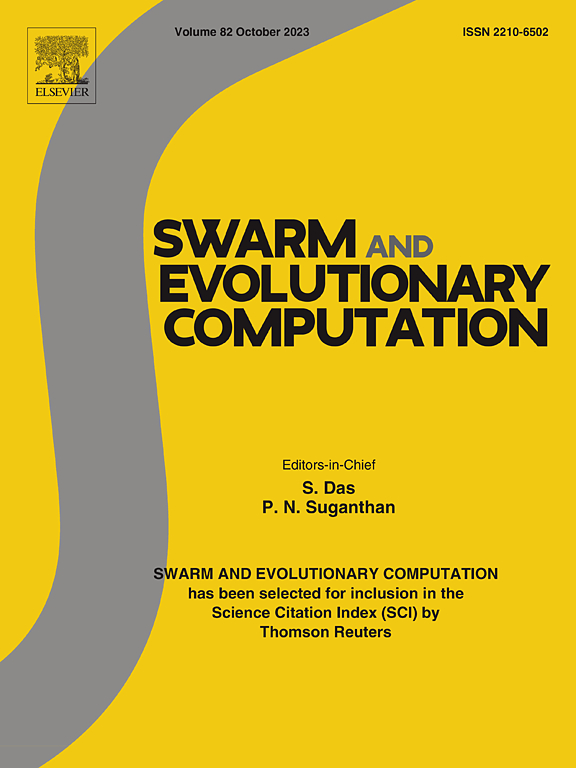Modelling and optimization of mixed-parallel straight and two-sided disassembly line balancing problem
IF 8.5
1区 计算机科学
Q1 COMPUTER SCIENCE, ARTIFICIAL INTELLIGENCE
引用次数: 0
Abstract
The recycling of end-of-life (EoL) products is an urgent challenge at present. Disassembly line layout plays a crucial role among the factors that affect recycling efficiency. Subsequently, this study proposed a mixed-parallel straight and two-sided disassembly line layout, combining the advantages of the three layouts to enhance the efficiency of recycling EoL products. Additionally, a mixed-integer non-linear programming (MINLP) model was developed to minimize the number of workstations, idle time balancing, demand, and hazard indices. To solve the mixed-parallel straight and two-sided disassembly line balancing problem (k-MPSTDLBP), this study designed a two-layer non-dominated sorting genetic algorithm-II (NSGA-Ⅱ) with universal encoding and decoding mechanisms. The algorithm’s effectiveness was validated by solving two hybrid cases using both the MINLP model and the two-layer NSGA-II. Moreover, comparative analyses with the non-dominated sorting genetic algorithm-III, the improved artificial fish swarm algorithm, and the improved firefly algorithm demonstrated the superiority of the two-layer NSGA-II. Finally, the two-layer NSGA-II was applied to a hybrid case study involving four types of EoL products under both the mixed-parallel straight and two-sided disassembly line and straight disassembly line layouts, confirming the higher recycling efficiency of the k-MPSTDLBP. Meanwhile, the sensitivity of the two-layer NSGA-II on the k-MPSTDLBP was analyzed using orthogonal experiments.
混合并联直、双面拆解线平衡问题的建模与优化
报废产品的回收利用是当前面临的紧迫挑战。在影响回收效率的因素中,拆解线布局起着至关重要的作用。随后,本研究提出了一种混合平行的直、双面拆解线布局,结合三种布局的优势,提高EoL产品的回收效率。此外,还开发了一个混合整数非线性规划(MINLP)模型,以最小化工作站数量、空闲时间平衡、需求和危害指数。为解决混合并行直、双面拆解线平衡问题(k-MPSTDLBP),设计了具有通用编码解码机制的两层非支配排序遗传算法-Ⅱ(NSGA-Ⅱ)。通过求解MINLP模型和两层NSGA-II混合情况,验证了算法的有效性。通过与非支配排序遗传算法- iii、改进人工鱼群算法和改进萤火虫算法的对比分析,证明了双层NSGA-II算法的优越性。最后,将两层NSGA-II应用于四种EoL产品的混合案例研究,包括混合平行直、双面拆解线和直拆解线布局下的混合案例研究,证实了k-MPSTDLBP具有较高的回收效率。同时,采用正交实验分析了两层NSGA-II对k-MPSTDLBP的敏感性。
本文章由计算机程序翻译,如有差异,请以英文原文为准。
求助全文
约1分钟内获得全文
求助全文
来源期刊

Swarm and Evolutionary Computation
COMPUTER SCIENCE, ARTIFICIAL INTELLIGENCEC-COMPUTER SCIENCE, THEORY & METHODS
CiteScore
16.00
自引率
12.00%
发文量
169
期刊介绍:
Swarm and Evolutionary Computation is a pioneering peer-reviewed journal focused on the latest research and advancements in nature-inspired intelligent computation using swarm and evolutionary algorithms. It covers theoretical, experimental, and practical aspects of these paradigms and their hybrids, promoting interdisciplinary research. The journal prioritizes the publication of high-quality, original articles that push the boundaries of evolutionary computation and swarm intelligence. Additionally, it welcomes survey papers on current topics and novel applications. Topics of interest include but are not limited to: Genetic Algorithms, and Genetic Programming, Evolution Strategies, and Evolutionary Programming, Differential Evolution, Artificial Immune Systems, Particle Swarms, Ant Colony, Bacterial Foraging, Artificial Bees, Fireflies Algorithm, Harmony Search, Artificial Life, Digital Organisms, Estimation of Distribution Algorithms, Stochastic Diffusion Search, Quantum Computing, Nano Computing, Membrane Computing, Human-centric Computing, Hybridization of Algorithms, Memetic Computing, Autonomic Computing, Self-organizing systems, Combinatorial, Discrete, Binary, Constrained, Multi-objective, Multi-modal, Dynamic, and Large-scale Optimization.
 求助内容:
求助内容: 应助结果提醒方式:
应助结果提醒方式:


